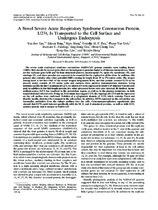| dc.description.abstract | The severe acute respiratory syndrome coronavirus (SARS-CoV) genome contains open reading frames
(ORFs) that encode for several genes that are homologous to proteins found in all known coronaviruses. These
are the replicase gene 1a/1b and the four structural proteins, nucleocapsid (N), spike (S), membrane (M), and
envelope (E), and these proteins are expected to be essential for the replication of the virus. In addition, this
genome also contains nine other potential ORFs varying in length from 39 to 274 amino acids. The largest
among these is the first ORF of the second longest subgenomic RNA, and this protein (termed U274 in the
present study) consists of 274 amino acids and contains three putative transmembrane domains. Using
antibody specific for the C terminus of U274, we show U274 to be expressed in SARS-CoV-infected Vero E6 cells
and, in addition to the full-length protein, two other processed forms were also detected. By indirect immunofluorescence,
U274 was localized to the perinuclear region, as well as to the plasma membrane, in both
transfected and infected cells. Using an N terminus myc-tagged U274, the topology of U274 and its expression
on the cell surface were confirmed. Deletion of a cytoplasmic domain of U274, which contains Yxx and
diacidic motifs, abolished its transport to the cell surface. In addition, U274 expressed on the cell surface can
internalize antibodies from the culture medium into the cells. Coimmunoprecipitation experiments also
showed that U274 could interact specifically with the M, E, and S structural proteins, as well as with U122,
another protein that is unique to SARS-CoV. | en_US |

